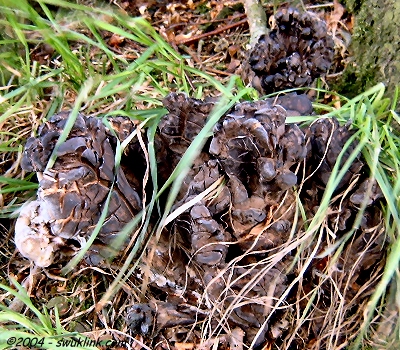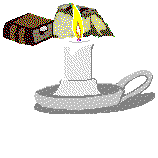
The fungi are a large group of living organisms which where formerly classified in the plant kingdom but, because of their uniqueness, are now considered as a separate kingdom within the Domain Eukaryota. As well as the species which display the conspicious 'mushrooms' and 'toadstools' (which are the fruiting bodies of the organism), the group also includes many microscopic forms such as the molds and yeasts.
About 70,000 species have so far been described but the number which actually exist may be as high as 1.5 million and the group has undergone substantial changes in the arrangement of the various taxa in the last several decades, especially as techniques for comparing their biochemical characteristics (e.g.: RNA and DNA) have become increasingly more sophisticated.
All lacking chlorophyl, in nature, fungi break down complex organic materials and are responsible for decay although they also attack living organisms. They also form close associations (symbiotic relationships) with plants, particularly the roots with which they grow in close contact, breaking down food in the soil which the plant can absorb in return for sugars photosynthesized by the plant - a mature oak tree can be associated with as many as four hundred individual species while many orchids will not germinate if the soil they fall on does not contain suitable fungi.
|
'Wet rot' and 'dry rot' infect and destroy building timber and can grow from a piece of infected timber for several metres along masonry to infect new timber.
Penicillin, the first antibiotic to be discovered, is obtained from a mold. The streptomycins are also obtained from fungi. Fungi also cause diseases such as athlete's foot, 'ringworm' and thrush.
Naturally present on the surface of fruit, yeasts break down sugars in the absence of air to produce
alcohol and carbon dioxide. This has long been used in brewing, winemaking and the leavening of bread.
History |
The sudden appearance and rapid growth of mushrooms and toadstools, their unusual shape rarely encountered elsewhere in nature, frequent bright colours, often hallucinogenic properties, and (sometimes) ghostly luminescence in the dark have always intrigued people and seemed to have been caused by some inexplicable, supernatural force and countless folk tales and songs have sprung up linking toadstools to fairies.
The Fairy Ring Mushroom grows in a circular formation, reputed to mark the boundary of the fairies' favorite dancing places. Enchanted by the fairies' music and revelry, mere mortal passers-by could be lured inexorably into the ring for what appears to be a few brief minutes but is actually years - sometimes even forever (a likely tale which must have been recounted amongst thew adventures of many a rogue).
|
In fact, the fungus starts its life in the middle of the ring and, with the passing of each year, grows outwards to digest and break down the fresh humus in the soil around it and abandoning the soil exhausted of nourishment in previous years. The breakdown of the humus by the fungal hyphae below the soil (the toadstool is only the fruiting body) also makes the nutrients available to the grass which grows more lushly at the edge of the ring - only adding to the 'magic' of the 'fairy ring'.
|
GERMANY
Mushrooms have been good luck symbols in the German culture for a long time and closely associated with nature and the beauty and mystery of the forest.
Finding a mushroom in the woods was like finding a lucky penny - good fortune was just around the corner.
Mushroom ornaments honor the reverence for nature and hopes for good luck in the coming year. |
The toxic effects of mushrooms are also elusive. Some contain enough toxins to immediately kill the person who eats them, like the Amanitas strain.
Other mushroom toxins poison people with a cumulative effect, basically building up in a person�s system over time.
A person could eat a certain mushroom many times with no reaction, and then die from the next mouthful because the overall poison levels become overwhelming to the body.
The effects of eating mushrooms makes hunting them a constant game of Russian Roulette, even for those who know what they�re doing. Before there were field guides, foraging festivals, and mushroom experts, mushrooms were often considered a strange and mystical occurrence.
Some mushrooms contain a chemical called luciferin, which causes the mushrooms to give off light reflected from their gills, making the ground glow in iridescent colors. This is called Foxfire.
Before Anglo-Saxon Britain knew what caused this, they derided mushrooms as nothing but �toadstools.�
No wonder they avoided celebrating mushrooms; imagine walking through a forest glade, the ground is aglow, and with small mushrooms growing in a ring, commonly known as a fairy ring around you. |
Because of the possibility of possibly fatal poisoning by fungi, collecting mushrooms for the table requires great care and only those mushrooms should be taken which can be identified with certainty. For the novice, the best way to start is to buy as good pocket-sized guide and take part in one of the many mushroom identification walks organised in the late summer and autumn at country parks or in woodland by the Forest Enterprise (the former Frestry Commission), etc.
The only mushrooms which can be identified readily and thus collected safely are the boleti, fungi of the genus boletus. The genus is unique in that the underside of the open caps is covered in tiny pores and not gills. Boletus edulis, known as the Penny Bun or by its French name of Cep, is considered by many throughout Europe to be the most prized of mushrooms after the famous truffle. Boletus satanus, the Devil's Boletus, is the only member of the genus which will be encountered which is unfit for culinary use but this is because of its unpleasant taste rather than any harm it might do. It is readily distinguished from the other Boleti by the redish coloration (greater or lesser in extent, but always present) on the stem.
PUFFBALLS
(Lycoperdon spp. and Calvatia spp.)
These round or pear-shaped mushrooms are almost always whitish, tan or gray and have no stalks.
Because of their bright white appearance, and depending on their size, puffballs have at varois times been mistaken at a distance for most things including golf balls and sheep.
The interior of a puffball is solid white at first, then turning yellow, then brown as the mushroom ages. Finally, the interior changes to a mass of dark, powdery spores, Size: 1\\\" to 12\\\" in diameter, sometimes larger.
When - late summer and autumn.
Where - in lawns, open woods, pastures, barren areas. On soil or decaying wood.
Caution - Each puffball should be sliced from top to bottom and the interior examined. It should be completely white and featureless inside, like a slice of white bread.
There should be no trace of yellow or brown and especially no sign of a developing mushroom with a stalk, gills and cap.
Amanitas, when young, can resemble small puffballs, but cutting them open will quickly resolve the question.
Cooking - Remove outer skin if it is tough, then slice, dip in batter and fry. |
Every spring and autumn, when the weather is warm and rainy the biggest mushroom flushes of the year happen..
Most of the people who pick mushrooms want to make sure that the tasty-looking morsels they have collected are in fact edible and won\'t send them racing to the emergency room a few hours after supper.
Often they are interested in collecting other wild mushrooms for the table but are aware of the dangers .
Because a few wild mushrooms are deadly and many more are mildly poisonous, mushroom hunting is not a hobby for the careless or uninformed.
Mushrooms are actually the fruit of a much larger being. Neither plant nor animal, mushrooms are classified as fungi. The main body is underground, or lives on dead trees and living tree roots and can vary in size from a few inches to several miles wide. When they absorb a large amount of water, they can grow amazingly fast. Their fruits sprout out of the ground overnight.
Humans and animals feed on the fruits of the mushroom body. There are over two thousand types of mushrooms, but only 2 � - 5 % are edible. The rest are highly poisonous and can masquerade as the edible ones. This can make foraging for mushrooms a risky and sometimes fatal business.
On the other hand, neither is it necessarily the death-defying feat that many people might imagine. There are a number of good edible mushrooms that are easy to recognize and hard to confuse with anything dangerously poisonous.
Poisonous mushrooms are often referred to as \"toadstools,\" but this is a folk name that has no precise meaning. |
 |
. . . this fungus was found in mid-September 2004 growing at the base of a beech tree in a small stand of beeches on Hackpen Hill (SU132755) on the Marlborough Downs in North-East Wiltshire. If you can identify it (or at least the genus), can you please email us by clicking here to email us. |
|
| | | Links to Other Pages on This Site
|
| |
| | |
|
| | | Links to Other Sites
|
| |
| | |
|
| | | Links to Other Pages on this Site
|
| |
| | |
Recommend a Book for this Page
Hits on this page since December 6th| Jan | | | | | Feb | | | | | Mar | | | | | Apr | | | | | May | | | | | Jun | | | | | Jul | | |  | | Aug | | |  | | Sep | | |  | | Oct | | |  | | Nov | | | | | Dec | | |  |
current year:  | | previous year:  |
2 messages posted on this page;- | Luciferin, the substance which makes some mushrooms glow is a strange stuff indeed - also present in the glow worm, when acted on by the enzyme luciferase, it creates light with nearly 100% efficiency (consider the incandescent lamp-bulb wastes 95% of the electrical energy as heat) | | posted 2004 Jul 13 4:09pm by webmaster@swuklink.com |
| . . . by way of afterthought, LUCIFERIN and the association of toadstools with the supernatural, is it derived from 'Lucifer'? | | posted 2004 Jul 13 4:12pm by webmaster@swuklink.com |
Only Members of the Site can post messages in this section. Signing in is easy from our Home Page. DISCLAIMER: Whilst we endeavour to ensure the content of this site is correct, we cannot undertake that information you find here, is, or will remain accurate and complete. We do not warrant that any information contained on this site is fit for any purpose. If you wish to place reliance on any such information you must check its accuracy by some other means before doing so. MEMBERS get aditional features on our pages and will soon be able to interact with the site and add their views and informastion. Sign up, from the Home-Page, is simple and involves typing in your email address and a password of your choice. If you are in any way connected with any location or interested in the subject mentioned on this page and have an hour or two a month to spare, we would welcome you as a local moderator - please email the webmaster by CLICKING HERE. Privacy Policy
|
| 







